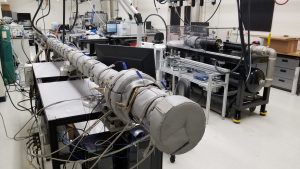Out research group is focused on identifying key chemical kinetics variations of different alternative fuels with a focus on jet fuels. Our fuels laboratory is equipped with an optically accessible high pressure rapid compression machine and shock tube facility as well as a GC/MS station of basic chemical structure analysis. The rapid compression and shock tube are both heated (up to 200ºC) and equipped with a direct test chamber fuel preparation method. A picture of our fuels research laboratory is shown below.

Fuels Research Laboratory
To date, our work has primarily focused on the low temperature NTC regions of the ignition in jet fuels. Shown below are relevant ignition delay curves for a variety of alternative and conventional jet fuel sources. It can be clearly seen that while the ignition delay tends to converge at higher temperatures, a clear deviation is seen as the temperature moves down (towards the right of the figure). These differences can have a significant impact on combustor performance. Much of the data can also be found on the FAA Alternative Jet Fuel Test Database which has been put together by our research group with FAA support.
Click here for connection to the FAA Alt Fuels Test Database: Link
 Ignition delays for various fuel sources [1]
Ignition delays for various fuel sources [1]
[1] Valco, D., G. Gentz, C. Allen, M. Colket, T. Edwards, S. Gowdagiri, M. Oehlschlaeger, E. Toulson, and T. Lee, “Autoignition Behavior of Synthetic Alternative Jet Fuels: An Examination of Chemical Composition Effects on Ignition Delays at Low to Intermediate Temperatures,” Proc. Comb. 35 (3), 2983-2991 (2015).

